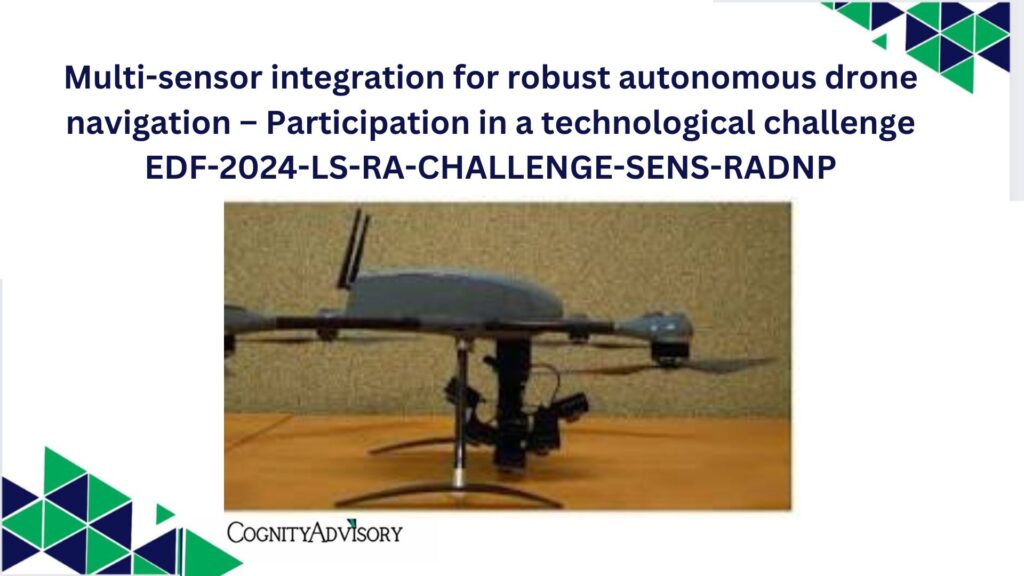EDF-2024-LS-RA-CHALLENGE-SENS-RADNP
General information
Programme
European Defence FundBudget overview
Call
Type of action
EDF-LS EDF Lump Sum Grants
Type of MGA
EDF Lump Sum Grant [EDF-AG-LS]
Open For Submission
Deadline model
single-stage
Opening date
20 June 2024
Deadline date
05 November 2024 17:00:00 Brussels timeTopic description
Objective:
To fulfil their missions, the next generation of unmanned aerial systems (UAS) are expected to offer an increased level of autonomy. Their effective deployment necessitates key features of swarming and navigation to target positions when GNSS availability is contested or lost and more generally in non-permissive environments. The use of various types of sensors (e.g. inertial, optical, infrared, hyperspectral, radar, LIDAR, acoustic, etc.) and intelligent information fusion are needed to provide the necessary capabilities to tackle these technical and operational challenges. Such intelligent navigation payloads should be usable on a wide range of unmanned assets, including in swarm formations, while having a low SWaP-C (Size, Weight, Power and Costs). Their performances should be measured in a quantitative, objective and comparable way.Scope:
The proposals must address technological solutions for autonomous aerial drone navigation in non-permissive environments. These solutions must be evaluated through the testing environment set up in the framework of the technological challenge.
Types of activities
The following table lists the types of activities which are eligible for this topic, and whether they are mandatory or optional (see Article 10(3) EDF Regulation):
| Types of activities(art 10(3) EDF Regulation) | Eligible? | |
| (a) | Activities that aim to create, underpin and improve knowledge, products and technologies, including disruptive technologies, which can achieve significant effects in the area of defence (generating knowledge) | Yes(mandatory) |
| (b) | Activities that aim to increase interoperability and resilience, including secured production and exchange of data, to master critical defence technologies, to strengthen the security of supply or to enable the effective exploitation of results for defence products and technologies (integrating knowledge) | Yes(optional) |
| (c) | Studies, such as feasibility studies to explore the feasibility of new or upgraded products, technologies, processes, services and solutions | Yes(optional) |
| (d) | Design of a defence product, tangible or intangible component or technology as well as the definition of the technical specifications on which such a design has been developed, including any partial test for risk reduction in an industrial or representative environment | Yes(optional) |
| (e) | System prototyping[1] of a defence product, tangible or intangible component or technology | No |
| (f) | Testing of a defence product, tangible or intangible component or technology | No |
| (g) | Qualification[1] of a defence product, tangible or intangible component or technology | No |
| (h) | Certification[1] of a defence product, tangible or intangible component or technology | No |
| (i) | Development of technologies or assets increasing efficiency across the life cycle of defence products and technologies | No |
Accordingly, the proposals must cover at least the following tasks as part of mandatory activities:
- Generating knowledge:
- Research on new approaches for robust autonomous navigation of unmanned aerial vehicles and systems in non-permissive environments.
- Participation to the evaluation campaigns organised in the framework of the technological challenge, including:
- contribution to the exchanges with the other stakeholders for elaborating the evaluation plans;
- participation of the unmanned aerial systems and software modules in experimental field and data-based test campaigns managed by the challenge organisers, whereby performance measurements are conducted to assess navigation capabilities;
- collection and sharing of sensor data;
- participation to debriefing workshops.
The proposals should substantiate synergies and complementarities with foreseen, ongoing or completed activities in the field of autonomous drone navigation.
Functional requirements
The proposed technologies should meet the following functional requirements:
- The unmanned aerial vehicles and systems should be able to accurately estimate their positions and to go to a designated target area with high reliability in non-permissive environments, where GNSS signals and communications may be degraded or lost.
- The performances for these abilities should be measured through the test campaigns conducted in the framework of the technological challenge, using protocols and metrics based on those described in the preliminary evaluation plan provided as part of the call documents. Details about how the proposed approaches and systems will address the tasks outlined in the preliminary evaluation plan should be described in the proposals. Any relevant system performances measured in the context of previous technological challenges should be mentioned in the proposals.
- Systems should be able to record the data acquired through their sensors to enable full replay of flights and reproduction of experiments in a software environment. The types of data that can be shared with other teams should be described in the proposals.
- The proposed approaches should be relevant for future integration and operational missions, especially in terms of SWaP-C. The user interfaces should help users and in particular pilots to understand and anticipate the system behaviours.
Expected Impact:
- enhanced UAS capabilities with highly autonomous operation modes for EU Member States armed forces, contributing to collaborative combat and tactical cloud capabilities;
- competitiveness, efficiency, and innovation capacity of the European defence technological and industrial base, which contributes to the Union strategic autonomy and its freedom of action.
